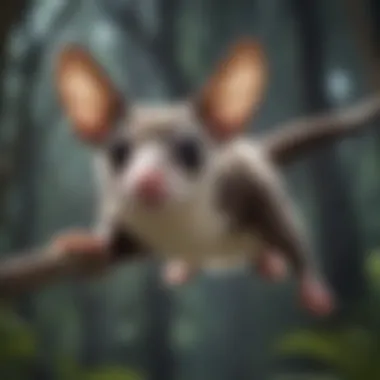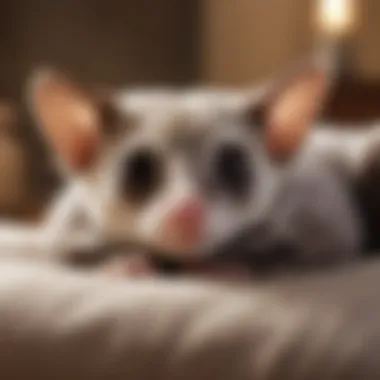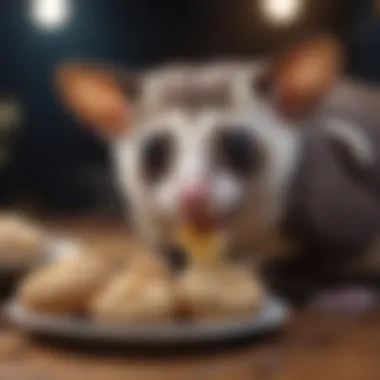Discover Fascinating Facts About Sugar Gliders


Pet Care Essentials
Sugar gliders, fascinating creatures native to Australia, require meticulous care to thrive in captivity. From daily nutritional needs to grooming requirements, understanding these petite marsupials is essential for nurturing a healthy bond. To ensure their well-being, a balanced diet rich in fruits, vegetables, and protein sources is crucial. Daily exercise and play sessions are vital to keep these active creatures entertained and prevent obesity. Regular grooming, including nail trimming and dental care, helps maintain their hygiene and health. Regular health check-ins with a qualified veterinarian are necessary to address any potential issues proactively.
Behavior & Training
Observing a sugar gliders' subtle body language cues is key to comprehending their emotional state and needs. Basic training techniques can be employed to foster a positive relationship with your pet, based on patience and positive reinforcement. Addressing behavioral concerns, such as biting or excessive vocalization, requires understanding the root cause and implementing suitable solutions. Socialization tips can aid in creating a harmonious environment for your sugar glider, ensuring they feel secure and cherished.
Pet Home Environment
Creating a welcoming and safe space for sugar gliders is paramount for their well-being. Designating a pet-friendly area with opportunities for climbing, gliding, and exploration mimics their natural habitat. Implementing safety measures to avoid potential hazards like toxic plants or small crevices is imperative. Providing a variety of toys and accessories encourages mental stimulation and physical activity. Establishing a cozy resting area with soft bedding and nesting materials offers comfort and security for these nocturnal creatures.
Pet Health Issues
Recognizing early signs of illness in sugar gliders is crucial for prompt intervention and treatment. Preventative care measures, such as a balanced diet and regular vet visits, play a pivotal role in maintaining their health. Familiarizing yourself with common ailments like calcium deficiencies or parasite infestations equips you to address issues swiftly. Having an emergency plan in place for unexpected medical crises ensures your sugar glider receives timely care and attention.
Introduction
Sugar gliders are captivating small marsupials that have gained popularity as exotic pets. These unique creatures are known for their endearing characteristics and fascinating behaviors, making them intriguing subjects for animal enthusiasts and pet owners alike. Understanding what sets sugar gliders apart and why they have become favored companions is essential in providing optimal care and ensuring a harmonious relationship between humans and these tiny gliders.
What are Sugar Gliders?
Sugar gliders, scientifically known as Petaurus breviceps, are small gliding possums native to the forests of Australia, Indonesia, and New Guinea. They are characterized by their membrane-like wing flaps, called patagium, which allow them to glide from tree to tree, resembling miniature flying squirrels. With a body length of around 6-7 inches and a striking membranous structure that extends from their fifth finger to their ankles, sugar gliders exhibit a truly unique physical adaptation for arboreal living.
Why are Sugar Gliders Popular as Pets?
Sugar gliders have captured the hearts of many as pets due to their adorable appearance, playful nature, and strong bond-forming abilities. These social animals thrive on interaction and companionship, making them ideal for individuals seeking a pet that can become a true companion. Their inquisitive behaviors, acrobatic skills, and soft vocalizations endear them to pet owners looking for an engaging and interactive relationship with their pets.
Purpose of the Article
The primary goal of this article is to provide a comprehensive insight into the world of sugar gliders, shedding light on various aspects such as their physical characteristics, behavioral traits, habitat requirements, and nutritional needs. By delving into the enigmatic realm of sugar gliders, readers will gain a profound understanding of these charming creatures and be equipped with the knowledge necessary to care for them responsibly. Whether you are a seasoned pet owner, a wildlife enthusiast, or simply intrigued by these marsupials, this article aims to satisfy your curiosity and guide you through the captivating universe of sugar gliders.
Physical Characteristics


In this section, we delve into the essential aspect of physical characteristics when discussing sugar gliders. Understanding their size, appearance, sensory adaptations, and life span is crucial for any individual interested in these mesmerizing creatures. By dissecting these physical traits, we gain a deeper appreciation for the uniqueness of sugar gliders and their evolutionary adaptations, shedding light on their captivating features that set them apart from other animals.
Size and Appearance
Distinctive Features
When exploring the distinctive features of sugar gliders, one cannot overlook their remarkable gliding membrane, known as a patagium, that enables them to glide through the air with grace and precision. This membrane, stretching from the front to hind legs, serves as a built-in parachute, allowing sugar gliders to navigate their arboreal habitat with remarkable agility. The patagium's efficiency in gliding showcases the evolutionary brilliance of these tiny marsupials, making them a popular choice for study among researchers and wildlife enthusiasts.
Color Variations
The color variations exhibited by sugar gliders add another layer of intrigue to their physical characteristics. From classic grey to striking albino variations, sugar gliders come in a diverse range of colors, each with its own unique charm. These color variations not only enhance the visual appeal of sugar gliders but also play a role in camouflage and thermoregulation in their natural environment. Understanding the significance of these variations provides insights into the adaptive capabilities of sugar gliders, enriching our understanding of their evolutionary journey and survivability in the wild.
Sensory Adaptations
Life Span
Behavioral Traits
In the realm of sugar gliders, understanding their behavioral traits is of paramount importance for any prospective or existing owner. These fascinating creatures exhibit intriguing behaviors that are not only captivating but also essential in providing them with appropriate care and ensuring their well-being. The behavioral patterns of sugar gliders, ranging from their nocturnal habits to their social nature and bonding with humans, offer a window into their unique world.
Nocturnal Habits
Sugar gliders are nocturnal beings, meaning they are most active during the night. This nocturnal behavior is a crucial aspect of their biology, as it aligns with their natural instincts and rhythms. Understanding and respecting their nocturnal habits is vital for creating a suitable environment that allows them to thrive. Owners must provide adequate lighting adjustments and quiet surroundings during the day to support their nighttime activity levels.
Social Nature
One of the most notable traits of sugar gliders is their highly social nature. These endearing creatures thrive in the company of their own kind and form strong bonds within their groups. As pets, sugar gliders also seek social interaction and companionship, making it essential for owners to consider their social needs. Providing opportunities for socialization, such as introducing them to other gliders or spending quality time interacting with them, enhances their well-being and mental stimulation.
Bonding with Humans
Contrary to popular belief, sugar gliders can form deep bonds with their human caregivers. Building a strong bond with these marsupials requires patience, trust, and consistent interaction. By establishing trust through gentle handling, offering treats, and spending time engaging with them, sugar gliders can develop a close relationship with their human companions. This bond not only enriches the pet-owner relationship but also contributes to the overall health and happiness of the sugar glider.
Habitat and Environment


Sugar gliders thrive in habitats that mimic their natural environment, ensuring their health and well-being. Understanding the intricacies of their habitat and environment is crucial for pet owners to provide appropriate care. Creating a suitable living space involves replicating the conditions of the wild, promoting physical and mental stimulation for these unique creatures.
Natural Habitat
In the wild, sugar gliders inhabit forests and woodlands in Australia, where they live in tree hollows. These arboreal marsupials are well-adapted to climbing and gliding, relying on their natural surroundings for shelter and safety. Mimicking their natural habitat in captivity involves providing vertical space to climb, along with suitable nesting options and materials to encourage natural behaviors.
Cage Requirements
Enclosure Size
The size of the enclosure is paramount for sugar gliders to exhibit their natural behaviors adequately. A spacious cage allows for ample room to glide, climb, and explore, promoting physical activity and reducing stress. The dimensions of the enclosure should accommodate multiple gliders comfortably, with vertical space for climbing and branches for perching. Ensuring adequate ventilation and maintaining cleanliness are essential for the gliders' health and overall well-being.
Environmental Enrichment
Environmental enrichment plays a vital role in keeping sugar gliders mentally stimulated and engaged. Providing a variety of toys, tunnels, and accessories simulates their natural foraging instincts and encourages physical activity. Incorporating branches, ropes, and platforms within the enclosure creates a stimulating environment for the gliders to exercise and play. Rotation of toys and environmental elements prevents boredom and promotes behavioral diversity, ensuring a happy and healthy lifestyle for these enchanting marsupials.
Nutritional Needs
Dietary Preferences
A deep dive into the dietary preferences of sugar gliders unveils their natural inclinations towards certain foods. While sugar gliders have a diverse palate, they exhibit preferences for specific food types. Fruits such as apples, berries, and grapes are typically well-received by sugar gliders due to their natural sugars and flavors. Vegetables like leafy greens and carrots provide essential vitamins and minerals to complement their diet. Proteins from sources like insects, eggs, and lean meats are also vital for their nutrition. Understanding their dietary preferences can help in creating a balanced and enticing meal plan for your sugar glider companion.
Feeding Guidelines
Navigating the feeding guidelines for sugar gliders requires a careful and informed approach. The feeding schedule for sugar gliders should incorporate a mix of fresh fruits, vegetables, proteins, and supplements to meet their nutritional needs. Providing a varied diet is key to ensuring they receive all essential nutrients for their well-being. Offering a small amount of food multiple times a day mimics their natural foraging behavior in the wild. Fresh water should always be available to keep them hydrated. Avoid feeding them excessive sugary treats or foods high in fats. By following proper feeding guidelines, you can contribute to the health and vitality of your sugar glider pet.
Reproduction and Parenthood
In delving into the realm of sugar gliders, understanding their reproduction and parenthood is crucial in comprehending their life cycle and care needs effectively. This section unveils the intricate processes these marsupials undergo, shedding light on their breeding patterns and Joey care requirements.
Breeding Patterns
Breeding patterns of sugar gliders are fascinating to observe, showcasing the intricate dance of nature. These small mammals typically exhibit seasonal breeding patterns, with females being induced ovulators, meaning they release eggs upon mating. The gestation period is relatively short, lasting around 15 to 17 days, after which a tiny underdeveloped joey is born. Male sugar gliders play a minimal role in parenting, making the female primarily responsible for nurturing the offspring.


Joey Care
Joey care is a critical aspect of sugar glider parenthood, requiring meticulous attention and specialized knowledge. Upon birth, joeys are undeveloped and reside in their mother's pouch for approximately 60 to 70 days, where they continue to grow and mature. As they emerge from the pouch, providing a conducive environment for their development is essential. Proper nutrition, warmth, and social interaction are vital for the well-being of joeys, ensuring they transition smoothly into independent, thriving members of the sugar glider community.
Health Considerations
When delving into the care of sugar gliders, understanding their health considerations is paramount. Ensuring the well-being of these enchanting creatures involves meticulous attention to various facets of their health. From diet-related factors to environmental conditions, every aspect plays a crucial role in maintaining their optimal health. Sugar gliders are prone to specific health issues that require diligent monitoring and preventive measures to safeguard their health and longevity. By addressing health considerations proactively, pet owners can enhance the quality of life for their sugar gliders, fostering a thriving and robust companion.
Common Health Issues
Common health issues in sugar gliders encompass a range of ailments that can affect their well-being. Respiratory infections, nutritional deficiencies, dental problems, and obesity are among the prevalent issues that sugar glider owners need to be vigilant about. Timely detection and prompt intervention are essential in managing these health challenges effectively. Regular health check-ups and a balanced diet are crucial in mitigating the risk of common health issues, promoting overall wellness and vitality in sugar gliders.
Veterinary Care
Securing proper veterinary care for sugar gliders is instrumental in maintaining their health and addressing any potential health concerns. Avian and exotic animal veterinarians with experience in treating small marsupials like sugar gliders are the ideal choice for comprehensive healthcare. Regular veterinary visits for health assessments, vaccinations, and parasite control are essential in safeguarding the well-being of sugar gliders. Additionally, pet owners should establish a strong partnership with a trusted veterinarian to seek guidance on preventive care strategies and prompt medical intervention when needed.
Legal Aspects and Regulations
When delving into the realm of sugar gliders, it becomes imperative to consider the legal aspects and regulations surrounding these captivating creatures. The legal framework governing the ownership and care of sugar gliders plays a crucial role in ensuring their welfare and conservation. Understanding the legal landscape not only safeguards the well-being of individual sugar gliders but also contributes to the preservation of their species in the wild.
Compliance with legal requirements is vital for both current and prospective sugar glider owners. By adhering to regulations and standards set forth by relevant authorities, individuals can contribute to the ethical treatment and responsible management of these charming marsupials. Legal aspects and regulations also serve as a means of preventing the unlawful trafficking and exploitation of sugar gliders, promoting their conservation and sustainable coexistence with humans.
Legal Status
The legal status of sugar gliders varies across different regions and jurisdictions. While these adorable creatures are recognized as legal pets in many countries, there are certain areas where restrictions or prohibitions may apply. It is essential for individuals interested in owning sugar gliders to research and understand the specific legal status in their locality.
In regions where sugar gliders are permitted as pets, owners are typically required to comply with certain regulations regarding their care, housing, and overall well-being. These regulations are put in place to ensure that sugar gliders receive proper nutrition, enrichment, and veterinary care, promoting their physical and psychological health.
Permit Requirements
Permit requirements for owning sugar gliders can vary widely, depending on the location and governmental guidelines. In some areas, obtaining a permit or license may be mandatory before acquiring a sugar glider as a pet. These permits often involve assessments of the owner's ability to provide adequate care and meet the welfare needs of the animal.
Permit requirements serve as a mechanism for regulating the ownership of sugar gliders, ensuring that potential owners are prepared to handle the responsibilities that come with caring for these unique creatures. By obtaining the necessary permits, individuals demonstrate their commitment to upholding legal standards and providing a suitable environment for their sugar gliders. It is essential to be well-informed about permit requirements and to fulfill them conscientiously to promote the well-being of sugar gliders and foster responsible pet ownership.
Conclusion
Final Thoughts
As we draw this exploration to a close, one cannot help but marvel at the wonder of sugar gliders. These small marsupials, with their gliding abilities and intricate social structures, occupy a unique niche in the animal kingdom. Through our journey, we have learned to appreciate their adaptability, nocturnal nature, and the joys of bonding with them. The comprehensive guide we have compiled not only serves as a valuable resource for current sugar glider enthusiasts but also acts as an educational tool for those interested in fostering a deeper connection with these fascinating creatures. By adhering to best practices in care, nutrition, and understanding their behavioral patterns, individuals can ensure the well-being and happiness of their sugar glider companions, creating harmonious environments where these remarkable animals can thrive.







